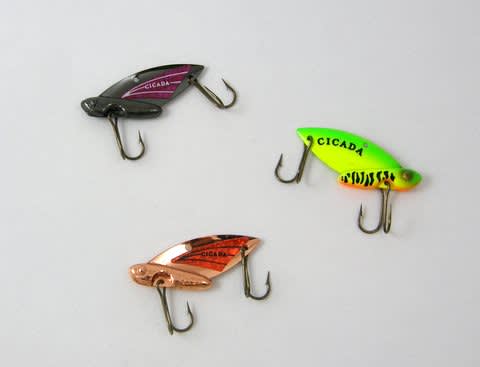Fishing Lessons from a Master Blade Runner
Dan Armitage 10.09.13

One of the best fall lures for fooling a variety of fish is one of the simplest: the blade bait. Consisting of little more than a metal head or belly molded to a thin blade stamped into the profile of a baitfish, blade baits are easy to fish, can catch any gamefish that likes to eat minnows, and are particularly productive when water temperatures begin to drop in the fall—or rise in the spring.
Popular blade baits include the classic Heddon Sonar, the Vibe-E, Reef Runner Cicada, the Gay Blade from Cordelle, and Worden’s Showdown, to name a few of nearly a dozen makers of the metal lures.
Blades can be cast and retrieved or trolled conventionally, but most anglers prefer to jig them vertically, using a simple lift-and-drop motion. That said, there is a wide range of lift speeds and distances that anglers use to fool autumn fish, and some anglers even stifle the drop or fall part of the retrieve, interrupting what would be a “natural” drop by adding action on the way down, or controlling its pace by keeping the line tight and dropping the lure at a slower-than-normal speed. Most fishermen agree that simply letting the metal blade drop at its own pace on a limp line is the most productive technique—and often when the take occurs.
In the autumn, when fish such as walleyes, crappies, bass, and trout are holding tight to structure, the late Ohio-based blade flipper and angler extraordinaire Jim Corey would cast to the shallows from a boat positioned just off the deeper edges to locate active fish. His hopping retrieve from the shallow flats to the depths beneath his boat imparted a leaping motion to the lure, which he made sure came into contact with the bottom between each short jump. After each hop, he recommended allowing the lure to flutter back to the bottom on a controlled slack line. Once the blade bait was worked back to below the boat, Corey would impart a vertical jigging action, allowing the lure to pound the bottom, sending up clouds of silt or ticking off gravel to attract fish in the area. After he determined the depth at which the active fish are holding, he focused on the productive blade presentation, either vertically jigging or casting.
When running his beloved blades, Corey was careful to match his tackle to the weight of the lure he was using. When fishing blade baits weighing 1/8- to 3/8-ounce in shallower inland waters, he preferred a six-foot, medium-action spinning rod. When angling deeper, open waters with blades that may weigh 1/2- to 3/4-ounce, Corey switched to a medium/heavy-action bait casting outfit. On the reels of both, he spooled Berkley Fireline, 10-pound-test on the spinning reel, and 14-pound-test on the bait caster, which he preferred for its casting capabilities and sensitivity. Using a double Uni-knot, he attached a leader of fluorocarbon and used a round-nosed snap to attach the lure. His leaders would test 10 pounds with the spinning rig and 15 pounds with the bait casting outfit, and were 18 to 20 feet in length.
“The Fireline alone sinks too fast, and the long fluorocarbon leader slows down the descent of the bait, which triggers more strikes,” Corey explained to me. “And when a fish is at the boat, I don’t like having a knot between me and the fish. The long leader means the weakest link—the knot—is on the spool when I’m landing the fish.”
Make sure you have an assortment of blades aboard your boat this fall, fish ’em like the late blade runner himself, and you’ll be reaching for the landing net in no time.

